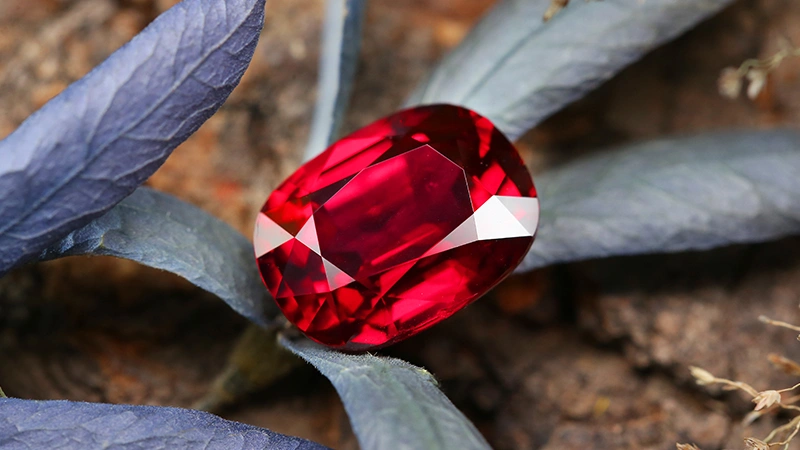It’s not uncommon to see a showdown between two gemstones resembling each other. Ruby vs spinel is one such case where even royalties got confused. Their resemblance of red color is so uncanny that in the past it didn’t spare the experts. Ruby and spinel are the two of the most sought-after and historical gemstones around. Also, they are very significant discoveries in the history of gemstone mining. We’ll talk about that in a while. Let’s first compare the two gemstones based on chemical composition, color, hardness and price.
Chemical Composition
A traditional jewelry stone, ruby is a variety of the mineral corundum, a crystalline form of aluminum oxide (Al2O3). This mineral crystallizes in slow-cooling igneous or metamorphic rocks with a precise set of ingredients. High proportions of aluminum (AI) and a lack of silicon (SI) results in the formation of corundum in the raw crystal. However, because silicon is one of the most common elements in the earth’s crust – for perspective, oxygen and silicon together constitute more than 74% of the earth’s crust – the formation of corundum is unique.
On the other hand, spinels are a subset of a large group of related magnesium aluminum oxide mineral species. Magnesium, iron, zinc, and traces of some other elements make up the crystalline structure of these species.

Color of Ruby vs Spinel
Ruby occurs in all varieties of red, from pinkish, purplish, orangey and brownish to dark red. People love rubies because this gem appears to glows in the sunlight. And it’s not magic but the stone’s fluorescence. Rubies have only one color – red. Though shades vary, color is the most significant factor for determining the value of a ruby gemstone. Pure red color rubies command the highest prices and often become heirloom. Ruby’s appealing red color is due to the presence of chromium in trace proportions in the mineral.
Variation in chromium causes variations in color, ranging from orange-red to deep purple-red. The more chromium present, the brighter the shade of red.

Unlike rubies, spinels come in a variety of colors, red being one of them. Others are blue, pink, orange, brown, lavender, black, gray, purple, lilac, red-orange, rose and light green. Some very rare spinels are also colorless. Despite having a wide and impressive array of color palette, the spinel gemstone is long known best as an imposter of ruby. However, spinel is a lovely gemstone in its own right. The many color options of this gemstone make it an excellent jewelry stone akin to sapphires. As with ruby and other gemstones, spinel also gets its color from different trace elements such as chromium, iron and cobalt, to name a few.
The presence of chromium and its intensity in the mineral’s crystal structure results in either orange, pink, or red spinels. Similarly, green spinel owes its color to the presence of iron in the mineral. Because of the overwhelming advantage of the many color options, the spinel gemstone outdoes ruby in terms of color.

Resistance To Scratching
Among natural gemstones, ruby has an extreme hardness score that’s second only to that of diamond. It scores 9 on the 10-point Mohs scale of hardness, meaning it offers commendable resistance to scratching, thus great wearability. Also, rubies don’t even have cleavage, which make a gemstone susceptible to chipping or falling apart. Therefore, they are undoubtedly superb jewelry stones that can be worn every day.
Much like rubies, spinels also lack cleavage and thus make good jewelry stones. The spinel gemstone provides superior resistance to blows and scratches and has a hardness score of 7.5 to 8 on the Mohs scale of hardness. Ruby does exceed spinel as regards hardness, but the difference between their hardness scores is not a deal-breaker for buyers. Spinels may score slightly lower but they’re as ideal for high contact everyday jewelry. such as engagement rings.

Price of Ruby vs Spinel
Ruby and spinel are two important gemstone discoveries that framed the world of gemology. For centuries, people have misidentified spinel as ruby, especially in Europe, Asia and the Middle East. Unless you’re the uninitiated, you know that some of the world’s most famous rubies were not rubies but spinels. Back in the day, people used to classify spinel gemstones as rubies out of ineptitude in distinguishing between these two gemstones.
Ruby and spinel are two important gemstone discoveries because distinguishing between these two gemstones led to the inception of the world of gemology. In 1783, French physicist and mineralogist, Jean-Baptiste Louis Romé de L’Isle, distinguished spinels as distinct mineral species. In that sense, ruby and spinel gemstones should command the highest per-carat prices of all the gemstones. However, that’s not the case. On the contrary, the per-carat prices of rubies are much more than that of spinels.

This difference in the per-carat prices of spinel and ruby gemstones can be attributed to the fact that rubies have long enjoyed the prestige born out of not only their beautiful shades of red but also the inability of people to separate spinels from rubies. I mean, all those esteemed rubies that were actually spinels – the Black Prince’s ruby and the Timur ruby, to name a few – indeed contributed a lot to the widespread adulation of rubies.

An Unfavorable Comparison
For most of its life, spinel has been known as ‘the great imposter’. This pejorative name was christened to the gemstone because of its checkered past. However, it’s a matter of rightful comparison when we say ruby vs spinel. Both rubies and spinels are beautiful gemstones, but we shouldn’t compare them simply because they appear similar.
But here’s what we can do. We can shop both natural rubies and spinels from GemsNY to adorn ourselves with history’s most important gemstones. So, after you…🙂









-S1-27410.webp)

